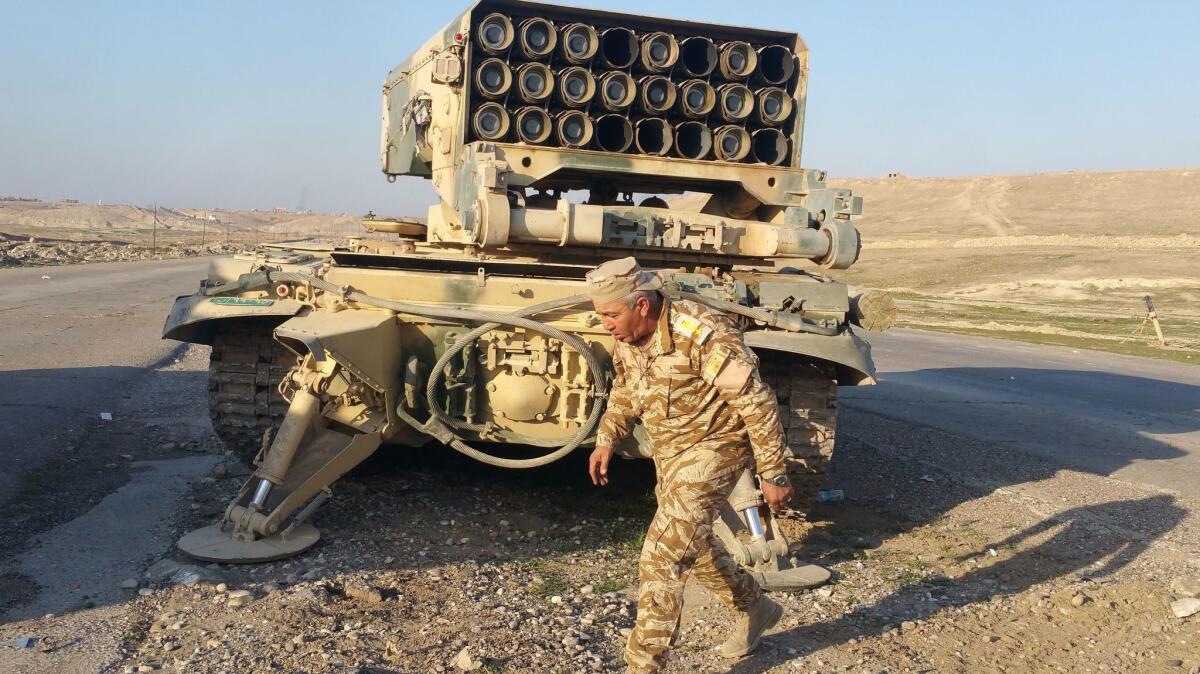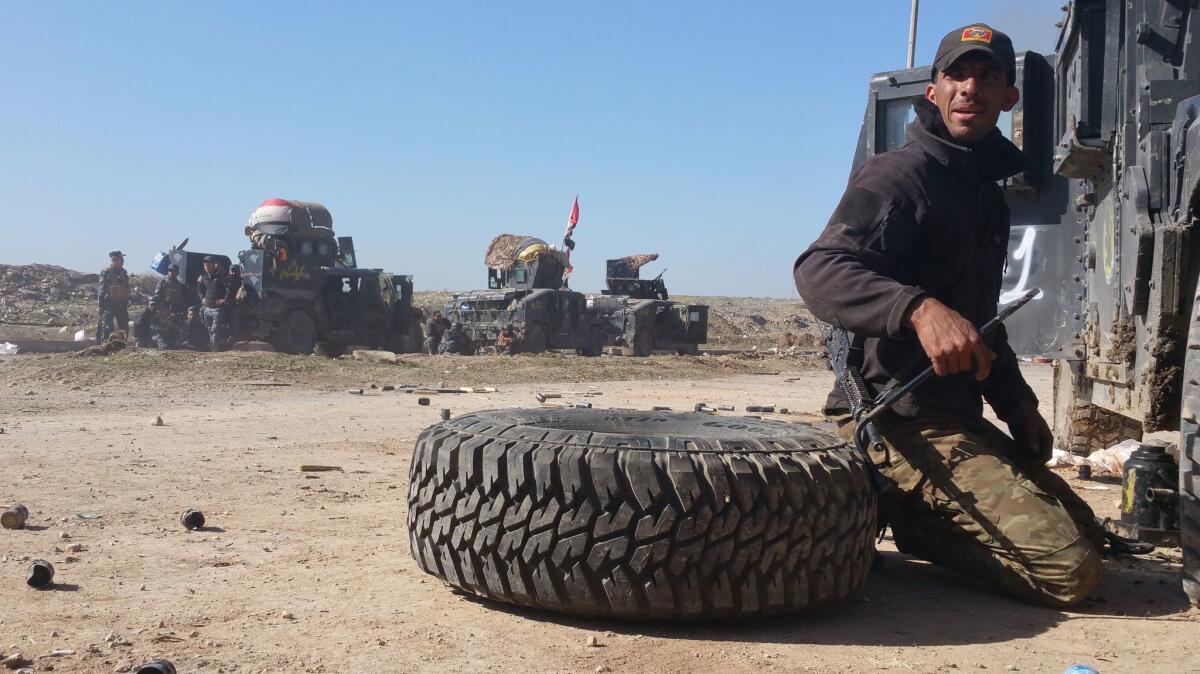Islamic State is showing stunning resistance as Iraqi troops try to breach west Mosul

- Share via
Reporting from Wadi Hajar, Iraq — It was around 3 p.m. when the Iraqi lieutenant finally accepted that his soldiers’ assault on Wadi Hajar, an industrial neighborhood in southwest Mosul, would not succeed.
Resting on the bumper of a battered black Humvee, he stared at the ground, his face pinched in anger and frustration. All around him was the urgent movement of men under fire, retreating.
“The resistance is just too strong from this direction,” said the lieutenant, a counter-terrorism officer who for reasons of security gave only his first name, Mustafa. “It’s Islamic State’s main defensive line from the south.”
The first week of the campaign for western Mosul started with rapid territorial gains for the government. Iraqi troops, backed by U.S. special forces and coalition warplanes, swept through lightly defended villages, tightening the noose on Islamic State’s last redoubt in the city.
But as the terrain has shifted from the desert to the urban, the pace has slowed and the casualties have mounted, suggesting the militants will not be routed from the city without a fierce fight.

The offensive, which started Feb. 19, is the second part of an internationally backed campaign launched last fall to take back the city, which the jihadists conquered in 2014 and made the capital of their self-declared caliphate. In the first part, the government seized control of eastern Mosul in 100 days of punishing combat.
The fight for western Mosul may prove harder, as the neighborhoods there have narrower streets and tightly packed buildings thought to shelter some of the jihadists’ most fervent supporters.
The difficulty is compounded by the government’s mandate to avoid high civilian casualties, a “concept of operations” that security forces had paid for “in blood,” Bruno Geddo, head of the United Nations refugee agency in Iraq, said in an interview last week.
Thousands of people have fled the carnage even as the government has urged the people of western Mosul — estimated to number 750,000 — to remain in their homes.

While government forces were making progress in some neighborhoods, Wadi Hajar was not among them.
Artillery and mortar shells rained down for hours Saturday as the crew of a Russian-made TOS-1 launcher a few miles away on the highway to Baghdad fired rockets at militant strongholds.
Meanwhile, dozens of government Humvees and armored personnel carriers lined up on the highway between the Mosul airport and the Ghazlani military base.
An armored bulldozer ripped through a sand berm half a mile away from Wadi Hajar, clearing the way for armored vehicles that raced up the highway.
“Don’t stop firing,” a commander ordered his men.
But then on the walkie-talkie came the first sign of trouble.
“I’m facing heavy fire in my direction, sir,” crackled a voice. “I can’t go forward. I’m being fired upon from 180 degrees.”

Behind the berm, the remaining troops waited for the order to advance. It never came.
Instead, they huddled behind Humvees for cover from the steady stream of bullets whistling all around them. Some soldiers furtively peeked out, ducking then scampering between the vehicles.
Then came a large explosion. It was a mortar round striking a police armored personnel carrier, engulfing it in flames. For a moment, thick acrid smoke gave the fighters respite from the snipers. But then ammunition still inside the vehicle began to explode, sending soldiers running for cover.
A few yards away, the lieutenant’s eyes were reddened by smoke and emotion.
“Some of my men are trapped inside,” he said, explaining that the police units had not advanced to give them support.
The men were hunkered down in a building, but the militants had wounded one of them and cut off their escape route.
“We’ll come and help you,” a commander told them over the radio. “We’ll send in a Humvee, drive right up to the building’s door…. Then we’ll open the door to give you cover and you can load the wounded man and come in one by one. Just keep on firing to make way.”
The voice on the other end quavered: “We have no ammo, and we can’t all come out from one end.”
Word came that an officer had been killed. His comrades loaded his body into a Humvee, but the vehicle was now on fire.
“I’m not leaving the martyr behind!” a soldier shouted.
Finally, two Humvees raced through the berm. As they came to a stop, troops rushed to the vehicles to help the wounded.
A wiry soldier named Murtadha stumbled out of one vehicle. He seemed to be in a trance.
Somebody opened a bottle of water and poured it over Murtadha’s head.
As the fighting subsided, the men began to eat their lunch, using their hands to scoop up handfuls of rice and zucchini tomato stew.
A few smiled tentatively. But the moment of relative calm quickly ended as an enemy mortar round screamed through the air and landed on a Humvee with a deadening thump.
“Everyone in the cars! Stop eating. We have to move,” shouted the lieutenant.
Behind him, another mortar round fell.
“We need to attack from another point,” he said. “This one won’t work.”
On Sunday, troops would try to breach Wadi Hajar in a fresh assault. It too would fail.
Bulos is a special correspondent.
ALSO
Islamic State has been cranking out car bombs on an industrial scale for the battle of Mosul
U.S. advisors are now fighting alongside Iraqi forces in the battle for Mosul
Defense Secretary James Mattis says U.S. air forces heavily involved in Mosul operation
To cross the front lines in the battle for Mosul, you just hail a cab
More to Read
Sign up for Essential California
The most important California stories and recommendations in your inbox every morning.
You may occasionally receive promotional content from the Los Angeles Times.











